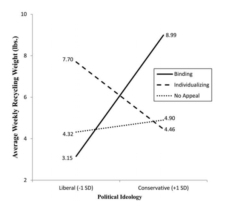How Do You Get Conservatives to Care As Much as Liberals About the Environment?
Answer: message to them differently.
More specifically, conservatives and liberals can see themselves as equally moral (Identity) but for very different reasons. Much like there is a Big 5 of Personality that is trait-based and predictive of attitudes and beliefs (and in turn, behavior), there is another Big 5 in Morality that, not surprisingly, has linkages to Personality.
The Big 5 in morality are groups of virtues and was originally conceived to better understand different cultures.
- Harm/Care: basic concerns for the suffering of others, includes caring and compassion.
- Fairness/Reciprocity: concerns for inequality or more abstract notions of justice
- Ingroup/loyalty: self-sacrifice for the group, feeling obligate to the group, vigilance against betrayal
- Authority/Respect: social order and appreciation of hierarchical relationships, sense of respect and obedience
- Purity/Sanctity: concerns about wholesomeness and physical and spiritual contagion.
These five statistically roll up into two larger groupings, #3-#5 and #1 and #2. The academics have, as is their wont, horrific labels for these two, Binding and Individualizing.
Conservatives tend to form moral judgements based on the Binding aspects of morality. They are more likely to adhere to social norms of their in-group (defined in lots of different ways – work, church, friends, family) and strive for self-control and duty. The group serves as the marker for what is moral. Tight knit communities serve to maintain this order.
Liberals are more focused on caring and fairness and using the individual as the reference point for determining good/bad moral behavior as they seek to protect the individual from harm and mistreatment.
Getting someone to give time or money or take an action is simple but not easy. At its core, it is about having the ask match the person’s sense of self.
That sense of self has layers and levels and is therefore, multifaceted. Nevertheless, if the message fits your psyche I have a much greater chance of success. If it doesn’t I have very little chance, especially if success is longer term, sustainable behavior – e.g. retention.
In a novel experiment researchers recruited participants with help from the local government to have their recycling bins outfitted with an RFID tag to precisely measure recycling behavior. These participating households were randomly assigned to one of three conditions; appeals promoting recycling that invoked Binding or Individualizing moral norms and a control group.
They used the first five weeks to establish a baseline of household recycling and then sent randomly assigned households one of two appeals (or nothing) at the beginning of each month for 3 months (test period). Afterwards, they were sent a survey to measure, among other things, their political ideology.

The results are nothing short of staggering.
- First off, Conservative households recycle as much as liberal ones with no intervention. This is the dotted line in the graphic below. There is no statistical difference.
- Second, when matched correctly, both groups greatly increase their recycling behavior – e.g. from 4.9 to 8.99 lbs for conservatives.
- And when mismatched, the amount of recycling actually goes down – e.g. 4.32 to 3.15 lbs for liberals.

How do you think your own control is doing? Is it the same for everybody? Why is your test going to a random nth group that assumes the impossible– that everyone who receives it is the same?
People are different and in predictable ways. Yet, they rarely reveal themselves with:
- Superficial (e.g. demographics) or
- Random (the clustering to nowhere so popular now) or
- Behavior based groupings (tells you next to zero about why).
Digging deeper by using theory is what’s required to get beyond one-size-fits-nobody and avoid the infinity problem when pondering the “how to segment and where to start” question.
Applying the science of “why” also greatly increases your chance of success. And success isn’t just segmentation success, it’s mission success. You are likely leaving almost countless dollars on the table by mismatching message to audience.
And if one cares about donors as people and individuals then the caring and fair choice is to recognize their differences and do your best to make them feel good about supporting you by having your messages match their sense of self.
And if one cares about donors to your cause as a group or as a set of ‘tribes’ then it’s your duty and obligation to better understand those groups.
Kevin
P.S. Applying the science of why to better fundraising is a core competence at DonorVoice, if you want (free) advice, ask.


